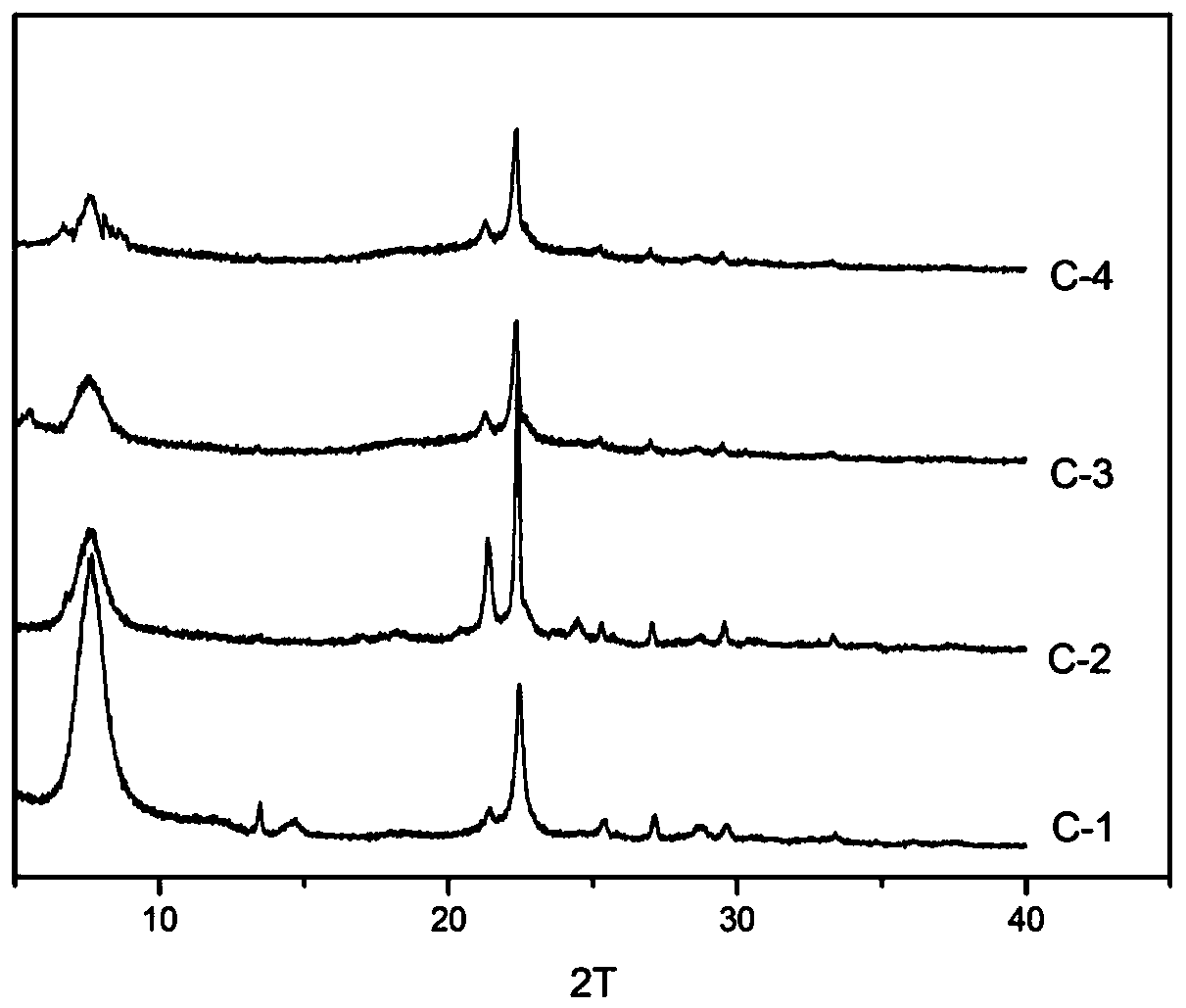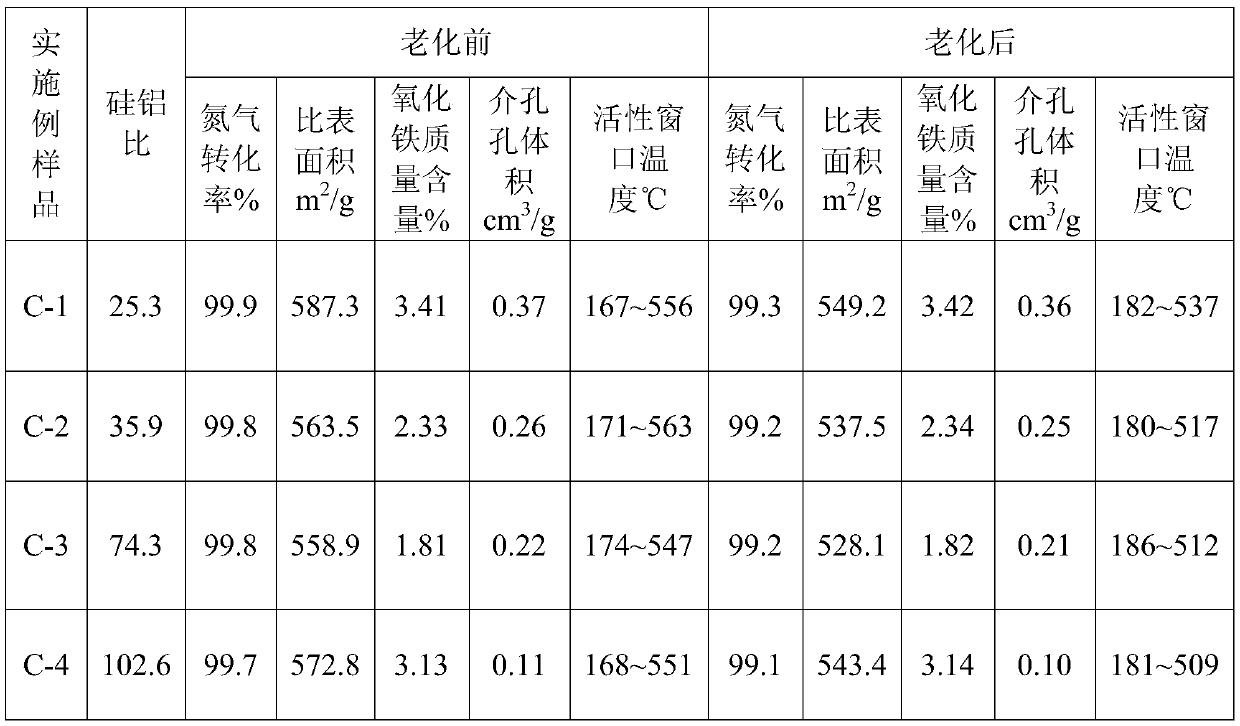Preparation method of mesoporous Fe-Beta molecular sieve
A fe-beta, molecular sieve technology, applied in separation methods, molecular sieve catalysts, molecular sieves and alkali exchange compounds, etc., can solve the problems of high cost, restricting the industrial production of Fe-beta molecular sieves, limited raw material sources, etc., and achieve moderate iron oxide content. , excellent hydrothermal stability and anti-sulfur poisoning ability, the effect of wide active window temperature
- Summary
- Abstract
- Description
- Claims
- Application Information
AI Technical Summary
Problems solved by technology
Method used
Image
Examples
Embodiment 1
[0030] Take iron-based molecular sieve production waste liquid, add appropriate amount of oxalic acid, adjust pH=5.3, and filter gum residue. After partial drying of the slag product, the amount and content of the silicon, aluminum, and iron oxides were detected as follows: SiO 2 :Al 2 o 3 :Fe 2 o 3 = 1:0.031:0.013. Take quantitative wet scum and disperse it in deionized water, add sodium hydroxide and tetraethylammonium hydroxide in turn, and stir evenly to prepare gel. The material ratio of each component in the gel is: SiO 2 :Al 2 o 3 :Na 2 O:Fe 2 o 3 :TEAOH:H 2 O=1:0.031:0.12:0.013:0.13:10. The gel was transferred to a dynamic crystallization kettle, and crystallized at 160° C. for 36 hours to obtain a product slurry. Fe-Beta molecular sieve (code: C-1) can be obtained after the slurry is removed from the mother liquor, washed, exchanged, dried and roasted.
Embodiment 2
[0032] Take iron-based molecular sieve production waste liquid, add appropriate amount of oxalic acid, adjust pH=4.7, and filter gum residue. After partial drying of the slag product, the amount and content of the silicon, aluminum, and iron oxides were detected as follows: SiO 2 :Al 2 o 3 :Fe 2 o 3 = 1:0.022:0.009. Take quantitative wet scum and disperse it in the filtrate, add sodium hydroxide and tetraethylammonium hydroxide in turn, and stir evenly to prepare a gel. The material ratio of each component in the gel is: SiO 2 :Al 2 o 3 :Na 2 O:Fe 2 o 3 :TEAOH:H 2 O=1:0.022:0.15:0.009:0.12:13. The gel was transferred to a dynamic crystallization kettle, and crystallized at 150° C. for 46 hours to obtain a product slurry. Fe-Beta molecular sieve (code: C-2) can be obtained after slurry is removed from mother liquor, washed, exchanged, dried and roasted.
Embodiment 3
[0034] Take iron-based molecular sieve production waste liquid, add appropriate amount of oxalic acid, adjust pH=3.3, and filter gum residue. After partial drying of the slag product, the amount and content of the silicon, aluminum, and iron oxides were detected as follows: SiO 2 :Al 2 o 3 :Fe 2 o 3 = 1:0.012:0.007. Take quantitative wet scum and disperse it in deionized water, add sodium hydroxide and tetraethylammonium hydroxide in turn, and stir evenly to prepare gel. The material ratio of each component in the gel is: SiO 2 :Al 2 o 3 :Na 2 O:Fe 2 o 3 :TEAOH:H 2 O=1:0.012:0.17:0.007:0.12:15. The gel was transferred to a dynamic crystallization kettle, and crystallized at 170° C. for 24 hours to obtain a product slurry. Fe-Beta molecular sieve (code: C-3) can be obtained after slurry is removed from mother liquor, washed, exchanged, dried and roasted.
PUM
| Property | Measurement | Unit |
|---|---|---|
| specific surface area | aaaaa | aaaaa |
Abstract
Description
Claims
Application Information
 Login to view more
Login to view more - R&D Engineer
- R&D Manager
- IP Professional
- Industry Leading Data Capabilities
- Powerful AI technology
- Patent DNA Extraction
Browse by: Latest US Patents, China's latest patents, Technical Efficacy Thesaurus, Application Domain, Technology Topic.
© 2024 PatSnap. All rights reserved.Legal|Privacy policy|Modern Slavery Act Transparency Statement|Sitemap



